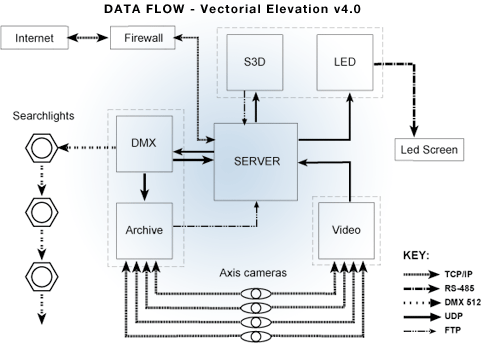Technology
Vectorial Elevation consists of a network of computers that process user requests on a first-come first-serve basis. Here are the different technologies involved:
The user reaches www.alzado.net and www.vectorialvancouver.net via a fixed IP address in the project control room. The web server is a Linux/Apache box behind a firewall. The server runs a queue programmed in perl and shell, serves pages and applets, relays video and sends emails to participants.
To participate the user needs a Google Earth plug-in which is available for Macintosh and PC. This shows Vancouver in 3D with an overlay of the project’s own content (3D models, markers and controllers). A Google maps interface allows the participant to select seachlights and move a virtual camera and a light target. When the participant submits a request the applet sends the exact x, y and z coordinates of each of the 20 virtual searchlights, as well as user information such as name, location and comments. The server queues this request.
When a request reaches the head of the queue, the data is sent to a 3D DMX application. This application knows the exact 3D position of each searchlight thanks to a calibration performed with GPS surveying. The DMX application sends appropriate DMX commands over a wireless signal to the 20 Syncrolite SX10K searchlights to direct them to the desired location. The SX10Ks are new-generation 10kW xenon robotic fixtures that produce a very collimated lightbeam.
When the searchlights produce the participant's design, four Axis webcams take digital pictures from the control room on the West End, the H.R. MacMillan Space Centre, a high rise on Beach avenue and the Vanier Park Marina. The images are watermarked with the participant's information using a custom-made application. As soon as the pictures are taken, a web page is built for the participant and an email is sent to him or her with its URL.
A user may view his or her web page by entering the personal code or by typing the URL in a web browser. The personal page contains the real and virtual images of the user's design as well as their name, location, date, time and comments.
A Flash applet allows visitors to see the four project cameras in real time. The video is subtitled with the name and location of the participant whose design is currently in the sky.
Current:
Last:
